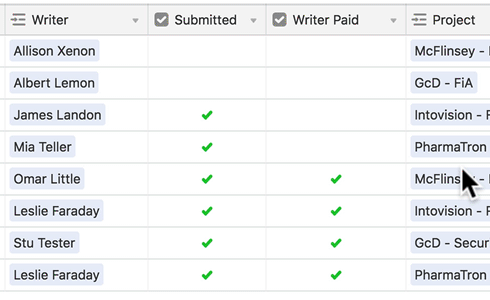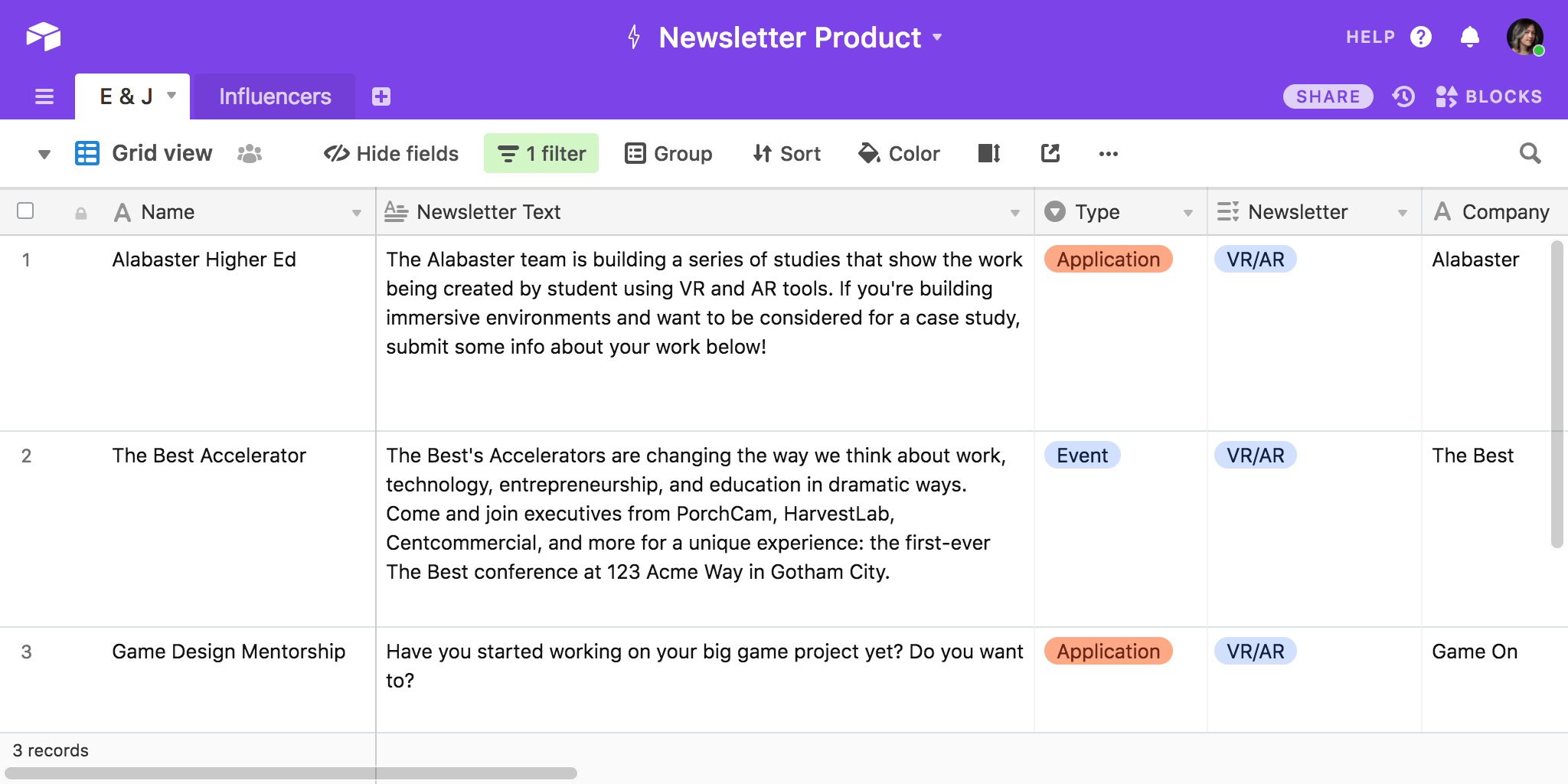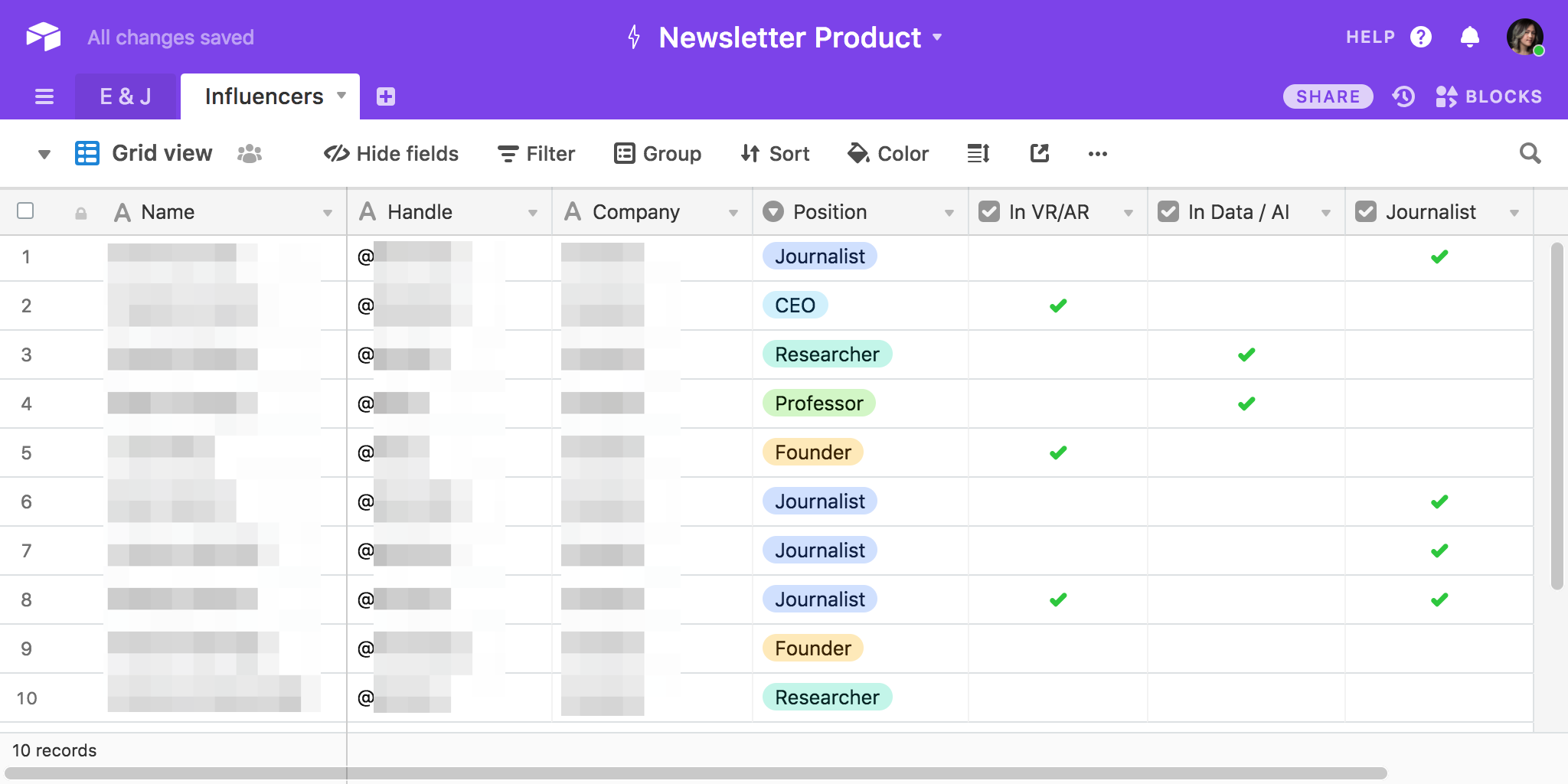Building a unique personality, voice, and brand while informing what you do with data is one of the central demands on content creators today. Too data-driven, and you risk creating something formulaic and paint-by-numbers. Too idiosyncratic, and you're ignoring valuable signals that can help you create better content.
This tension makes many content creators nervous. For The Edge Group founder Ranjan Roy, it's a source of inspiration.
The Edge Group uses machine learning-driven curation—processing content from tens of thousands of articles—combined with input and guidance from human experts and writers to produce white-labeled email newsletters and newsfeeds for companies like Boston Consulting Group, NYC Media Lab, and TIME.
Most of their clients are in financial services and consulting and are looking for cutting-edge content on topics like blockchain, corporate acquisitions, VR, and AR. They use The Edge Group's content for two main purposes: as an internal educational tool and as marketing collateral.
“People will give us specific topics, and we use an algorithm we built to pull relevant and fresh stories,” Roy says. “Then we have a team of writers who write actual blurbs for each external and internal newsletter in a more conversational, modern voice, and the finished product gets fully white labeled with the client's logo.”

Managing everything The Edge Group does is a big job. There are clients, invoices, writers, projects, deadlines, assets, and other moving parts that need to be managed every day.
Running the company that creates all this customized content for sophisticated knowledge producers, in other words, requires an equally sophisticated group of people and processes on the back end—which is where Airtable comes in.
A spreadsheet whiz hits a hard limit
Before using Airtable, Roy tried all kinds of tools to help him keep track of invoices, clients, and work. The stickiest product, the one he kept coming back to, was the humble spreadsheet.

“I used to work in finance, so I'm an Excel person. I kinda think in a spreadsheet way. I like listing things out and connecting cells, and that's just how I take notes or manage my own personal stuff,” Roy says.
“But Excel can't store files in a cell, or manage documents, or help you share things with the right people,” he adds. It was his love of the basic spreadsheet and its widespread utility—but his discouragement with its limitations—that brought him to Airtable.
From a document storage-meets-spreadsheet-meets-small business management perspective, Airtable is incredible.—Ranjan Roy, founder & CEO of The Edge Group
“What I really like about Airtable is that I can set it up to run everything,” he says. “I can manage when contractors invoice me, which newsletters have been paid for, what's been submitted, what's not been submitted. I can operate this whole side of the business from within Airtable, but it's also easy to create shared public views, so I don't have to get a separate tool or platform to get that information in front of and stay in touch with clients.”
Today, Roy uses Airtable to manage invoices, which writer is writing what piece of content and when, and the editorial calendar as a whole. He even uses Airtable as a vehicle for content deliverables that get sent straight to clients.
Track everything happening inside the business
Until he started using Airtable, Roy struggled to keep track of all his documents and spreadsheets because his tools and workflow weren't designed to help keep track of those documents and spreadsheets—a problem that most people who have used modern SaaS project management tools know well.
“Trying to save PDFs in Asana or even in a Google Drive folder, trying to manage all that—stuff just gets lost very easily,” Roy says. “And then you can never actually tie it to 'Which client is this specifically?' or 'Which project is this specifically?'”
The Airtable base that Roy built for The Edge Group lists each discrete piece currently in motion, its due date, the assigned writer, whether the piece has been submitted, whether the writer has been paid, and the client project it is for—and it also includes a field for attachments, so he never loses track of the actual file.
From here, Roy can easily set up views to send each writer to show what they're going to be responsible for. All he has to do is create a new grid or calendar view, apply a filter so that the view only shows the relevant projects for a specific writer, and then click the Share button to create a share link showing just those projects. Once he sends that share link to the writer, that writer gets a personalized representation of all the pieces that they need to worry about, without seeing the articles being written by every other writer on the team.

Once a writer finishes a piece and sends it to Roy, he can take a look and see if it needs any revisions. After going back and forth with the writer to get the piece finished, he can click a checkbox in a field called "Submitted" in the Airtable base to indicate that the piece is done.
To handle the next step—paying the writers for the work they've done—Roy has another table in the same Airtable base that collects all of the information he needs to finish his invoices:
- the employee's name
- the invoice amount
- the work done
- the date of the invoice
- the payment date
- the period covered by the invoice

When the invoice is processed, he can then go back to that original table and hit the “Paid” checkbox.

“To be able to manage all our projects in one place, and then hit one of two checkboxes to update, one, who I owe how much money to and two, have they gotten paid? Everything is just right there,” Roy says. “From a document storage-meets-spreadsheet-meets-small business management perspective, it's incredible. There's nothing else I've seen that can do this.”
Running this all out of Airtable brings Roy a lot of other side benefits. He can easily get a glimpse of each individual project and see exactly how much working product it entails, how much revenue it brings in, and how important it is to the business overall.

He can also track which clients have paid him and related information—when he's sent out the invoice, when the invoice is due (using a simple date-addition formula), and whether it's been paid.

Airtable allows Roy to manage all of the most important information that runs through his agency at any given time—what projects need to be done, who is working on them, and whether or not everyone has been paid for their work.
Deliver structured, collaborative content to clients
Recently, Roy's started experimenting with using Airtable not just to manage his editorial calendar but also to deliver content to clients in a more structured, collaborative way.
Sending documents seems a simple and straightforward way of delivering work product, but using Airtable to run his business led naturally to an experiment with using Airtable to do that as well.
The problem with a complex document like an email campaign, especially when that campaign runs over the course of several months, is that you often have lots of moving and changing parts to deal with.
For many of Roy's clients, that meant:
- different events to promote depending on the week and the newsletter
- different external influencers to reach out to to help promote the content
- different job listings and other opportunities to include
Managing all these changing elements in individual documents would mean endless versioning issues and emailing back-and-forth—kind of like running an agency without Airtable did, previously.
By using Airtable to deliver work, Roy found that he could skip all that and instead deliver a database version of each campaign to his clients—allowing the two of them to work collaboratively to keep their campaigns stocked with the right information and copy from week to week.

Content creation is important, but just as important for Roy and his clients is making sure that the content they create gets out there to the people who can help promote it and spread the word.
Roy's clients often have prospective social media influencers in mind, but lack the time to reach out to collect and reach out to them on their own. And in addition, each email newsletter he helps run has a different group of pertinent influencers connected to it.
To manage these, Roy and his client assembled a list of influencers, then Roy added those to the content product Airtable base with flags for subject matter inclusion, allowing his team to tailor the influencers contacted to the topics actually being covered in a particular newsletter.

With an entire newsletter formatted into a base, it suddenly became much easier for Roy to communicate over what to include and how it would look week after week.
“Before, it was a mess in terms of trying to coordinate what we included last week and what we need to include this week,” Roy says. “Before, they would Slack us some stuff, email some stuff, Twitter DM some stuff, and stuff would get lost. And now, they can copy and paste right into a simulation of the final product, add some text here, a URL there, and so on.”
“What I really like about it is that it's providing the client with a really simple, structured way to look at the work we're delivering and add their feedback and fixes,” he adds.
Since the newsletters are a weekly production, sometimes a client will want to advertise a certain job or opportunity for a certain number of weeks and then cut it off.
This is the kind of detail that normally adds another layer of logistical complexity. Roy solved it by adding a field called “Include Thru” that allowed his client to add this information themselves to the product's Airtable base.
“They'll add it or tell us a date to include it through and then we will know right away, each week, whether to keep it in the newsletter or not. So this has been very helpful in both communicating with the client and managing this stuff ourselves,” Roy says.
Giving the client an easy way to make a change to the body text of that week's newsletter, update the date through which a certain ad should run, and add to the list of influencers who will be contacted—this is what makes delivering content through Airtable different.
“We're probably saving at least a few hours each week with this base for this client, but it's also improved our relationship with them. Before, stuff would slip through the cracks. There might be a job listing they had promised some important person that would be included and then it would not make it into one of the newsletters, that kind of thing,” Roy says. “So this has actually tightened everything up and really improved our relationship with them.”

It's not just asking the client to use your system because it saves you time—it does that, but it's also saving the client time and giving them peace of mind that everything is being taken care of. Because the whole content product and its distribution model lives in Airtable, clients don't need to worry about their requests slipping through the cracks or getting lost in a far-flung doc—the product lives in Airtable, the representation of it there reflects reality perfectly, and delivery can move along at a quick cadence.
“Once we showed them that here is this specific place where in one click you can change the view, and you can filter exactly what articles showed up in last week's newsletter, what events and jobs showed up on the May 5 edition, here are all the journalists that you want to try to tweet at this week, and you don't have to even filter through a huge list anymore—that's where they'd really started liking it,” Roy says.
